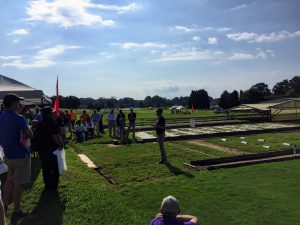Activities of the Georgia Envirotron facility include interdisciplinary researches in Environmental Science, Food Safety, Crop and Soil Sciences, Entomology, Plant Pathology, Urban Agriculture etc. Research summaries of leading scientists, graduate, undergraduate and Young Scholars Internship students are presented below (selected).
- Research at the Envirotron
- Research at the Rainout Shelters
- Collaborative Research Projects
- Young Scholars Program
- Refereed Publications

Understanding Drought Tolerance for Breeding Warm-Season Grasses
David Jespersen, Assistant Professor, Crop and Soil Sciences
Drought stress is a major environmental stress which damages and limits the growth of warm-season grasses. A collaborative project among several universities in the southern United States, including the University of Georgia, was formed to evaluate the drought performance of several warm-season grasses including bermudagrass, zoysia, St. Augustine grass, and seashore paspalum. In addition to characterizing drought tolerance of a wide selection of experimental varieties, important physiological responses to drought were further detailed in select varieties of bermudagrass and seashore paspalum to better understand potential mechanisms for drought tolerance. This project will ultimately advance the ability of turf breeders to develop improved varieties which can withstand severe levels of drought.
Impact of Reel to Bedding Knife Relationship of Reel-type Mowers on Soil Volumetric Moisture Content in a TifEagle Bermudagrass Putting Green.
Waltz, C., P. Raymer, D. Jespersen, V. Tishchenko, C. Bennett, and L. White
Maintaining mowing equipment is essential to turfgrass health and maintaining a quality golf putting surface. There are two philosophical approaches to the relationship between the cutting reel and the bedding knife. The traditional approach involves “slight” contact between the reel and bedding knife, providing a scissor-type cut. In the second approach, the reel becomes a gatherer, bringing the grass leaves to the bedding knife, acting like a scythe where there is no contact between the reel and bedding knife. In the no contact approach there is a 0.051 mm (0.002-inch) gap, relying on a sharp bedding knife to cut the grass. The objective of this study was to investigate if either mower setup affected water use of TifEagle bermudagrass (Cynodon dactylon x C. transvaalensis Burtt-Davy) maintained under golf course putting green conditions. The study was conducted under an automatic rain exclusion shelter set to close upon sensing 0.51 mm (0.02-inch) rain. With this facility the plots were able to receive full sunlight and natural environmental conditions in the absence of rain. TifEagle sod was laid on 15 cm of a USGA specification sand, underplayed with a sandy soil, and allowed to establish for 45 days. During the establishment period, the plots were regularly irrigated, fertilized, topdressed with sand, and rolled to ensure establishment and surface smoothness. From the initial mowing, two John Deere mowers were setup, one contact and one no contact, and used to mow the plots. During the establishment period the mowing height was progressively lowered to 3.4 mm (0.135-inch), the height maintained throughout the study. During the construction of the plots in situ moisture probes were inserted 1.5in (3.8cm) below the surface at eight locations, four in contact plots and four in no contact plots, and connected to a data logger. During the summer of 2016, there were four, 5-day dry down cycles where rain was excluded and irrigation was not applied. During the dry down cycles plots were mowed daily and volumetric moisture data were collected from in situ probes, as well as, with two topically inserted TDR (FieldScout TDR 300) and capacitance (Pogo) probes. With the TDR probe volumetric moisture content was measured at two depths, 3.8 and 7.5 cm. Leaf clipping were collected daily during the mowing process (i.e. clipping taken from the mower basket while being mowed) to measure relative leaf water content. Visual turfgrass quality ratings were also recorded. After each dry down, plots were allowed 10 to 15 days to recover from drought stress and before the initiation of the next dry down. The soil moisture trends, regardless of measurement technique, were consistent across the dry down events and reflected the visual ratings where the plots maintained with the contact mower setup having higher turfgrass quality.